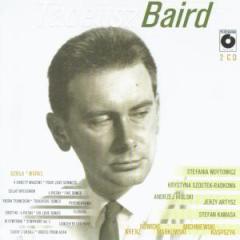Tadeusz Baird – Concerto Lugubre for Viola & Orchestra
Tadeusz Baird – Concerto Lugubre for Viola & Orchestra

1. Movement 1 2. Movement 2 3. Movement 3 Stefan Kamasa – viola Cracow Symphony Orchestra Jacek Kasprzyk – conductor
Tadeusz Baird's Concerto Lugubre for viola and orchestra (1975) was commissioned by Nurnberger Filharmoniker and was first performed by that orchestra with Stefan Kamasa as the soloist and Hiroyuki Iwaki as the conductor in Nuremberg on 22nd May 1976. The Polish premiere took place in 22nd September the same year, during the 20th Warsaw Autumn International Festival of Contemporary Music, featuring Stefan Kamasa again and the Katowice Polish Radio and Television Orchestra under Jacek Kaspszyk.
Concerto Lugubre is a kind of a requiem in memory of Baird's mother who died in 1974, and the murky "lugubre" mood is present in it all the time. The form possesses a number of features of a classical concerto for a solo instrument and orchestra, and the structure of expression is clearly rooted in historical standards. A traditional three-movement construction can be discerned, the viola solo part displaying the "main theme" in the dramatic first movement through a series of two-sound and three-sound combinations played with robust bow strokes. A strong contrast is offered by the second movement, which is filled with plaintive lyricism. Finally the third movement brings the rushing anxiety of fast notes interrupted by the viola chord "theme" from the first movement. The music dies off in a subtle reverie the way it was born out of subtle sounds. The emotions of Concerto Lugubre have romantic roots, as does a lot of Baird music. However, far from being abused, they work on the listener's sensitivity with tenderness and care in order not to tire him with excessive tension.
Concerto Lugubre is a rare specimen of a viola concerto - the viola being almost always treated as an instrument of an orchestra or a chamber ensemble - and a highly attractive one to play, too, for the viola part is both a virtuoso and an emotional show. Baird's choice of the solo instrument was not a chance one, the viola's dark sound and colour fitting the subject and mood of the music. It is worth noting that the viola is supported in a special way by two instruments: a deep, mournful sounding kettledrum and a darkly coloured, gloomy alto flute.
Concerto Lugubre's direct yet subtle emotionality, its obvious references to tradition and, perhaps, its accessibility have earned it a place within the small group of works of contemporary music which are played at subscriber philharmonic concerts and are liked by the everyday music lover who is used to listening to Beethoven and Tchaikovsky. --- culture.pl
Utwór powstał na zamówienie Nürnberger Filharmoniker i przez ten zespół został po raz pierwszy wykonany 22 maja 1976 roku w Norymberdze. Solistą był Stefan Kamasa, dyrygował Hiroyuki Iwaki. W Polsce pierwsze wykonanie odbyło się 22 września tego samego roku podczas XX Międzynarodowego Festiwalu Muzyki Współczesnej „Warszawska Jesień”. Grał Stefan Kamasa z Orkiestrą Polskiego Radia i Telewizji w Krakowie pod dyrekcją Jacka Kaspszyka.
Concerto lugubre jest swego rodzaju requiem, poświęconym zmarłej w 1974 roku matce kompozytora. Mroczny nastrój „lugubre” przenika cały utwór. Jego forma ma wiele cech klasycznego koncertu na instrument solowy i orkiestrę, podobnie struktura wyrazowa nawiązuje wyraźnie do wzorców z przeszłości. W Concerto lugubre można dostrzec tradycyjny układ trzyczęściowy. Część pierwsza, o dramatycznym charakterze, eksponuje w solowej partii altówki „temat główny”, zbudowany z szeregu dwudźwięków i trójdźwięków atakowanych zdecydowanymi pociągnięciami smyczka. Silny kontrast z częścią pierwszą tworzy część druga, przesączona smutnym liryzmem. Wreszcie fragment finałowy przynosi pędzący niepokój szybkich nut, przerwanych akordowym „tematem” altówki z części pierwszej. Cały utwór zamiera zaś w subtelnej zadumie, tak jak z podobnie subtelnych brzmień wyłonił się jego początek. Emocja Concerto lugubre ma korzenie romantyczne, tak jak to jest zresztą w wielu utworach Bairda. Ale kompozytor nie nadużywa emocji, oddziaływuje na wrażliwość słuchacza bardzo subtelnie i z rozmysłem, aby nie znużyć nadmiernym napięciem.
Concerto lugubre jest rzadkim przykładem koncertowego utworu dla altówki. Ten instrument traktowany jest niemal wyłącznie jako składnik orkiestry lub zespołu kameralnego. Tadeusz Baird dał przy tym altowiolistom dzieło bardzo atrakcyjne wykonawczo. Partia altówki jest zarówno wirtuozowska, jak i bogata emocjonalnie. Wybór solowego instrumentu nie był jednak przypadkowy. Tematyce i nastrojowi całego utworu odpowiada barwa altówki, jej ciemne brzmienie. Warto zauważyć, że wspierają altówkę w Concerto lugubre w sposób szczególny dwa instrumenty: kotły o głębokim, żałobnym brzmieniu i altowy flet o barwie ciemnej, pochmurnej. Dzięki swojej bezpośredniej, ale subtelnej emocjonalności, za sprawą oczywistych nawiązań do tradycji i zapewne dla swoich wartości estradowych ten utwór Tadeusza Bairda znalazł się w niewielkiej grupie utworów współczesnych, które trafiają do programów abonamentowych koncertów filharmonicznych i podobają się zwykłem melomanom, nawykłym do słuchania Beethovena i Czajkowskiego. ---polmic.pl
download: uploaded anonfiles gett mega 4shared mixturecloud yandex mediafire ziddu
Last Updated (Sunday, 18 August 2013 15:06)








